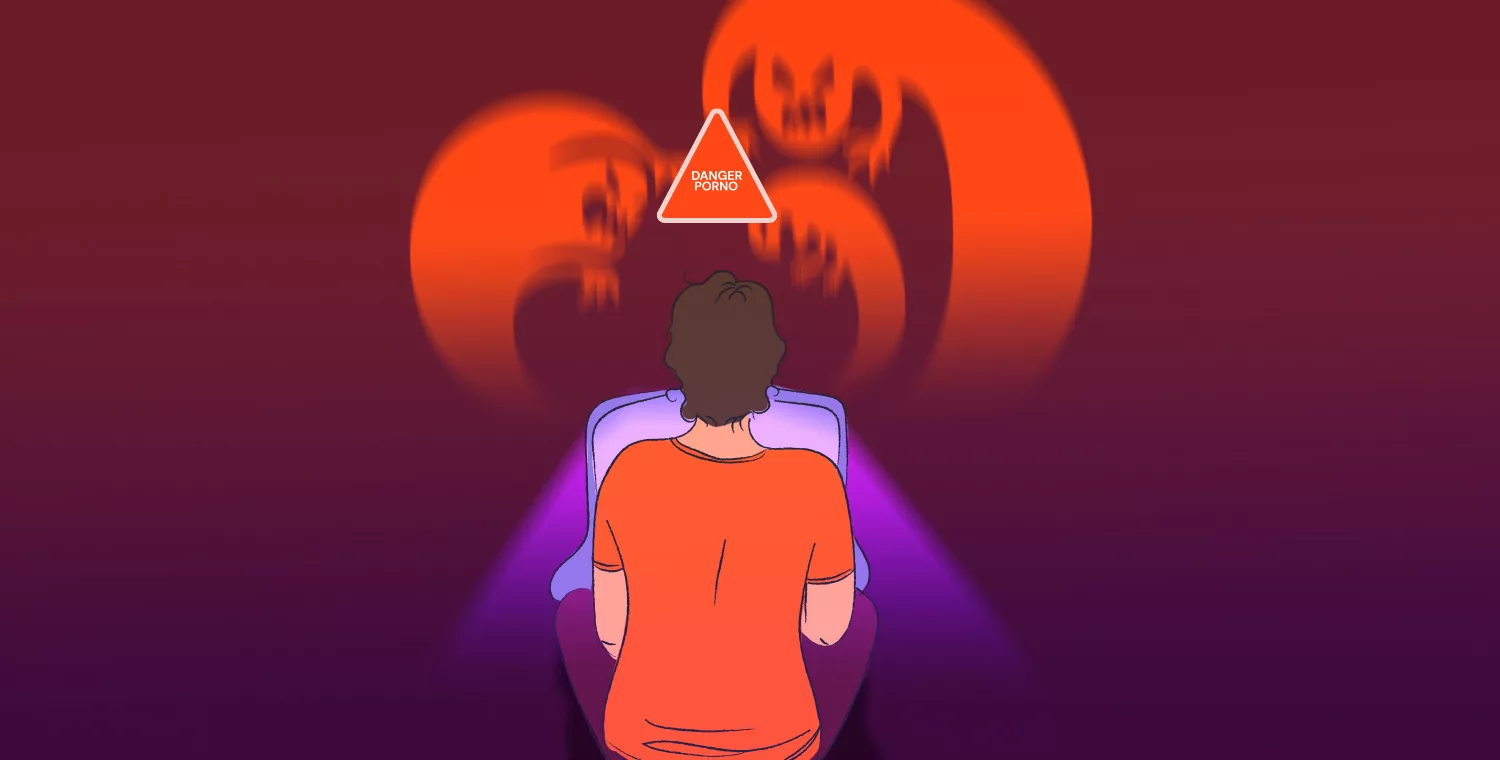Your cart is currently empty!

Is Pornography Consumption Actually Dangerous?
This text has been annotated by Mélodie Nelson, author and former sex worker.
As mentioned in our previous article on pornography addiction, there are many negative beliefs circulating about porn. Two of these beliefs are that porn destroys romantic relationships and incites violence against women.
Given that this kind of discourse is nothing new and that sexuality has historically been fraught with unfounded fears, beliefs, and taboos (Horowitz, 2002), I admit to being sceptical of such claims.
But should I be? What does the research say?
Does porn consumption cause relationship problems?
“I don’t find it easy to discuss sex in my relationship and clearly state what I want (maybe I don’t know myself well enough yet?). I watched porn on the sly for a few years (while in a relationship) and I didn’t feel good about it. When my partner found out, we had a big discussion. My lie almost broke our relationship.”
The belief that porn is harmful to relationships has also been around for a long time, as has research that has found links between pornography consumption and sexual and relationship dissatisfaction, sexual difficulties, and relationship conflict.
The thing is, when we take a look at most pornography research, we see that its results are mixed and inconclusive. Both negative and positive effects are reported. This is partly due to the fact that there are a host of methodological and conceptual problems with many of these studies. Campbell and Kohut (2017) have identified the following:
- Definitions of pornography vary from one study to another and, most of the time, all porn types, formats, and contents are put in the same basket.
- Most studies on porn focus on its potential negative effects by assuming, examining, and then confirming that porn harms relationships. Let’s just say that this significantly limits what we can learn about the typical impact of pornography on couples, since its potential “neutral” and “positive” effects are usually overlooked.
- The vast majority of these studies only collect data from one partner rather than from both, which has the effect of camouflaging the relational context in which pornography is consumed.
- Lastly, the hypotheses in many of these studies, as well as the reasoning behind them, are often replete with stereotypical gender assumptions (for example, that straight men all enjoy watching porn, while their partners all have negative attitudes towards porn and their partner’s porn consumption). When the very structure of a study is based on such biases, we end up with invalid or unreliable results (as researchers like to say, “garbage in, garbage out”).
So, what have the more nuanced studies found regarding the effects of porn on relationships?
According to a study of 430 heterosexual people in relationships, most of them said that pornography consumption had no negative impact on their relationship, and many indicated that pornography had a positive impact on their relationship and highlighted, for example, that it fostered sexual exploration and better communication (Kohut et al., 2017).
Only a minority of people reported negative effects (for example, that porn creates unrealistic expectations in the bedroom or that it leads to less love and intimacy). The results of a national study conducted in Norway point in the same direction (Koletić et al., 2021).
In another study that used data collected from both partners, couples in which both partners used porn reported better sexual communication and greater levels of closeness compared to couples in which only one partner watched porn (Kohut et al., 2018).
That said, it seems that the moral context in which pornography is consumed is important to consider. In a study conducted with a large heterosexual sample and with data collected from both partners, the researchers found that pornography consumption was linked to better relationship satisfaction in men who were more accepting of pornography (Maas et al., 2018).
With respect to a partner’s pornography consumption, this study also found that having positive attitudes towards porn was a protective factor against relationship dissatisfaction, among both women and men.
Does pornography consumption lead people to develop negative attitudes towards women and sexually assault them?
“Sometimes there is violence [in the porn I watch]. I feel guilty about being turned on by it.”
Many people believe that porn consumption can lead many consumers (let’s be real, in this context, people are talking exclusively about heterosexual cisgender men) to reduce women to sexual objects and to sexually assault them, because pornography itself degrades women, sexual objectifies them, and promotes violence against them by showing scenes in which they are subjected to acts of violence.
In an effort to raise awareness on these harmful effects, some organizations, such as Fight the New Drug, even cite scientific studies showing that mainstream pornography is full of depictions of acts of aggression against women.
But (yes, there is a huge “but”), by directly consulting the research they cite, we soon realized that not everyone shares the same definition of the words “aggression” and “violence”.
For example, by analyzing 4009 scenes of straight mainstream pornography, Fritz and colleagues (2020) found that 45% of those from Pornhub and 35% of those from XVideos contained physical aggression, which was mostly perpetrated against women. The most common acts of aggression were spanking, gagging, slapping, hair pulling, and choking.
Another of these studies found similar results, in addition to finding that almost 50% of the scenes analyzed contained verbal violence, especially in the form of insults and name-calling, and that the women reacted mainly with pleasure or with a neutral expression (Bridges et al., 2010).
Here’s the thing: if it’s desired and consensual, well… it’s not assault. By the way, I don’t know about you, but many people are turned on by these types of sex acts and, according to research, they don’t constitute a minority.
According to a large North American survey, sexual fantasies involving some form of rough sex (e.g., bondage, domination/submission, discipline, sadism/masochism, “rape” fantasies, etc.) are the second most common (Lehmiller, 2018). In fact, in this study, more than one in four people indicated that it was their favourite fantasy, and the majority of people have had this type of fantasy at least once: only 4% of men and 7% of women have never had this fantasy.
“I like power play and domination [in porn], but I’m never sure if the performers’ consent and boundaries have been respected in the porn I watch, and that makes me uncomfortable. I wouldn’t want to encourage sexual exploitation unknowingly.”
That said, it’s important to remember that not everyone wants to act out their sexual fantasies! Many prefer to keep them in their imagination or in the porn they consume (because, let’s be honest, porn is essentially sexual fantasies in literary, audio, visual, or audiovisual form), where they can be enjoyed safely and in privacy.
Also, let’s not forget that our fantasies don’t define us. For example, liking getting spanked during sex does not mean that one likes being submissive or getting spanked in life in general. Sexuality and eroticism are way more complex than that! Context is everything.
So, let’s go back to the original question: does consuming porn lead people to develop negative attitudes towards women? In a large representative U.S. sample (over 25,000 participants!), the people who used porn had more egalitarian attitudes than people who didn’t (Kohut et al., 2016). Moreover, according to the same study, porn consumers were as likely as non-consumers to identify as feminists.
Okay, but does consuming porn lead straight men to assault women?
Systematic reviews of studies that examined this issue have either found no link (Ferguson & Hartley, 2009), or have found that porn use does contribute to sexual violence, but only in a minority of individuals who are already predisposed to sexual violence (Fisher et al., 2013; Kingston et al., 2009).
More recently, a study showed that men with hostile attitudes towards women were more likely to resort to sexual coercion and violence when they used porn often, rather than infrequently (Baer et al., 2015). According to the same study, these men were also more likely to consume violent porn than non-violent porn (and here, we’re really talking about violence and not merely consensual rough sex or BDSM).
So, it would seem that the problem is not porn per se, but rather sexism and misogyny.
-
Baer, J. L., Kohut, T. et Fisher, W. A. (2015). Is pornography use associated with anti-woman sexual aggression? Re-examining the Confluence Model with third variable considerations. The Canadian Journal of Human Sexuality, 24(2), 160-173. https://doi.org/10.3138/cjhs.242-A6
Bridges, A. J., Wosnitzer, R., Scharrer, E., Sun, C. et Liberman, R. (2010). Aggression and sexual behavior in best-selling pornography videos: A content analysis update. Violence Against Women, 16(10), 1065-1085. https://doi.org/10.1177/1077801210382866
Campbell, L. et Kohut, T. (2017). The use and effects of pornography in romantic relationships. Current Opinion in Psychology, 13, 6-10. https://doi.org/10.1016/j.copsyc.2016.03.004
Crooks, R. L., & Baur, K. (2017). Nos sexualités, 3e édition [Our sexualities, 3rd edition]. Modulo.
Doucet, P. (2020). Ces tabous tenaces. La masturbation, la pornographie et l’éducation. [These stubborn taboos: Masturbation, pornography and education]. Québec Amérique.
Ferguson, C. J. et Hartley, R. D. (2009). The pleasure is momentary… the expense damnable?: The influence of pornography on rape and sexual assault. Aggression and Violent Behavior, 14(5), 323-329. https://doi.org/10.1016/j.avb.2009.04.008
Fisher, W. A., Kohut, T., Di Gioacchino, L. A. et Fedoroff, P. (2013). Pornography, sex crime, and paraphilia. Current Psychiatry Reports, 15(6), 1-8. https://doi.org/10.1007/s11920-013-0362-7
Fritz, N., Malic, V., Paul, B. et Zhou, Y. (2020). A descriptive analysis of the types, targets, and relative frequency of aggression in mainstream pornography. Archives of Sexual Behavior, 49(8), 3041-3053. https://doi.org/10.1007/s10508-020-01773-0
Horowitz, H. L. (2002) Rereading sex: Battles over sexual knowledge and suppression in ninteenth-century America. Knopf.
Kingston, D. A., Malamuth, N. M., Fedoroff, P. et Marshall, W. L. (2009). The importance of individual differences in pornography use: Theoretical perspectives and implications for treating sexual offenders. Journal of Sex Research, 46(2-3), 216-232. https://doi.org/10.1080/00224490902747701
Kohut, T., Baer, J. L. et Watts, B. (2016). Is pornography really about “making hate to women”? Pornography users hold more gender egalitarian attitudes than nonusers in a representative American sample. The Journal of Sex Research, 53(1), 1-11. https://doi.org/10.1080/00224499.2015.1023427
Kohut, T., Fisher, W. A. et Campbell, L. (2017). Perceived effects of pornography on the couple relationship: Initial findings of open-ended, participant-informed,“bottom-up” research. Archives of sexual behavior, 46(2), 585-602. https://doi.org/10.1007/s10508-016-0783-6
Kohut, T., Balzarini, R. N., Fisher, W. A. et Campbell, L. (2018). Pornography’s associations with open sexual communication and relationship closeness vary as a function of dyadic patterns of pornography use within heterosexual relationships. Journal of Social and Personal Relationships, 35(4), 655-676. https://doi.org/10.1177/0265407517743096
Koletić, G., Štulhofer, A., Hald, G. M. et Træen, B. (2021). Self-assessed effects of pornography use on personal sex life: Results from a large-scale study of Norwegian adults. International Journal of Sexual Health, 33(3), 342-356. https://doi.org/10.1080/19317611.2021.1918310
Lee, J.. (2015) Coming Out Like a Porn Star: Essays on Pornography, Protection, and Privacy. ThreeL Media.
Lehmiller, J. J. (2018). Tell me what you want: The science of sexual desire and how it can help you improve your sex life. Da Capo Lifelong Books.
Maas, M. K., Vasilenko, S. A. et Willoughby, B. J. (2018). A dyadic approach to pornography use and relationship satisfaction among heterosexual couples: The role of pornography acceptance and anxious attachment. The Journal of Sex Research, 55(6), 772-782. https://doi.org/10.1080/00224499.2018.1440281
Penley, C. (2016). “A Feminist Teaching Pornography? That’s Like Scopes Teaching Evolution!” The Feminist Porn Book. The Politics of Producing Pleasure.The Feminist Press.
Tarrant, S. (2016). The Pornography Industry: What Everyone Needs to Know. Oxford University Press.

If reading this article has piqued your curiosity, there’s an episode of our podcast, À quoi tu jouis?, that tackles the myths and realities of pornography (available in French only).






